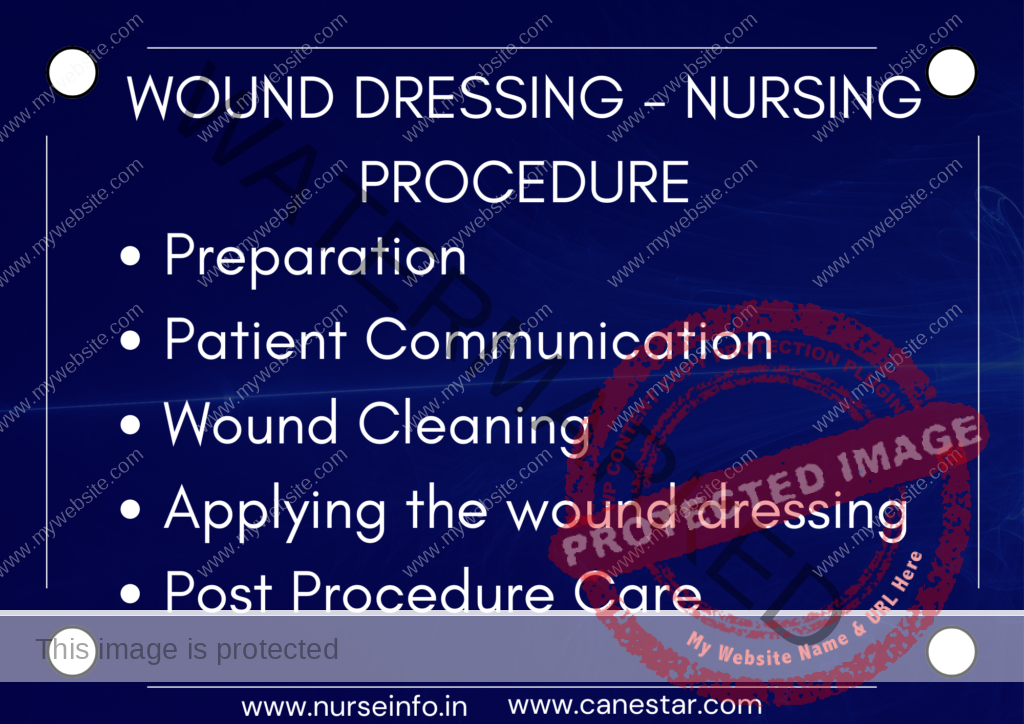WOUND DRESSING –
Nursing Procedure – Types,
Care of Skin, Principles
WOUND DRESSING – Nursing Procedure – Types, Care of Skin, Principles
WOUND DRESSINGS
Dressings vary according to size, location, depth, stage of ulcer, and preference of the ordering practitioner. Commonly used dressing materials include hydrogel dressings, poly-urethane films, hydrocolloid wafers, biological dressings, alginates and cotton gauze. These materials promote an optimum healing environment. Hypoallergenic tape should be used to secure dressings if tape is necessary. Protective paste may be applied to protect non affected tissue from topical agents. In all cases, pressure should be kept off the wound. No treatment will be effective if pressure continues to damage the tissue
NURSING PROCEDURE
SKIN CARE
Skin is a protective cover and an important part of the body. It has two layers namely epidermis and dermis, sweat and sebaceous glands are situated between these two layers. The outer cover which protect the skin against heat and light, injury and infection. Skin regulates body temperature and stores water, fat and vitamin D. the skin which weighs about 6 pounds is the body largest organ.
TYPES OF SKIN
- Normal skin: a skin that is neither very dry nor very oily is called normal skin
- Dry skin: that is never moist on touching is called dry skin
- Oily skin: when the sebaceous glands are more active is called only oily skin
- Mixed skin: many people have mixed skin. Part of their body is only (like face) and remaining part is dry
CARE OF SKIN
Skin is always in touch with the external environment. Due to this, dirt, chemical substances smoke particle of petrol or diesel gets deposited on skin. These particles can obstruct opening of skin holes and also affected function of the skin it is essential to pay attention to cleanliness of skin for good health
PRINCIPLES OF THE SKIN CARE
1. Intact skin and mucous membrane protect for body against injury, diseases
Action: all nursing actions are focused to keep the integrity of the skin. Pressure and friction on the skin can cause tissue injury. This will leads to formation of decubitus ulcer. Change position every 2 or 4 hourly; provide a soft, smooth and unwrinkled bed can prevent bedsores
2. Excessive moisture in contact with the skin for a period of time can result in the tissue irritation
Action: the nurse’s efforts should be focused to keep the client dry always
3. Pathogens grow well in a warm and moist environment greater organisms are increase possibility of infection
Action: when giving the bath to the client, pay attention in some areas of the body e.g. axillae, the groin under the breast, between finger and toes. Two skin surfaces are always in contact with each other, so it is necessary to clean and dry
4. The skin that is poorly nourished and dry has less ability to protect and is more vulnerable to injury.
Action: to maintain the health of the skin, a well balanced diet with vitamin A, B, C and protein are necessary. Dehydration of the body leads to cracks on skin and mucous membrane and ulcer formation. The client is protected from dehydration, fever, excessive sweating, vomiting, diarrhea etc.
5. Sensory receptors in the skin are sensitive to heat, pain, touch and pressure
Action: the temperature of the water should be regulated according to the tolerance and likes of the clients. Every movement of the nurse should be gentle so as not to cause pain to clients
6. Hygienic practices vary individuals, between people of different economic status and between cultures.
Action: bathing and application of skin preparation according to their culture influences. The nurse whenever possible to allow the client to have his usual bathing practices
7. Systematic ways of working saves times, energy and materials.
Action: arrange all articles before starting the procedure. Sponging is done systematically starting from head to foot. Change water whenever necessary.
8. Any unfamiliar situation produces anxiety.
Action: explain the procedure to secure confidence and cooperation of the clients. Provide privacy by placing screens. Drape the client properly and exposed only the needed part.

